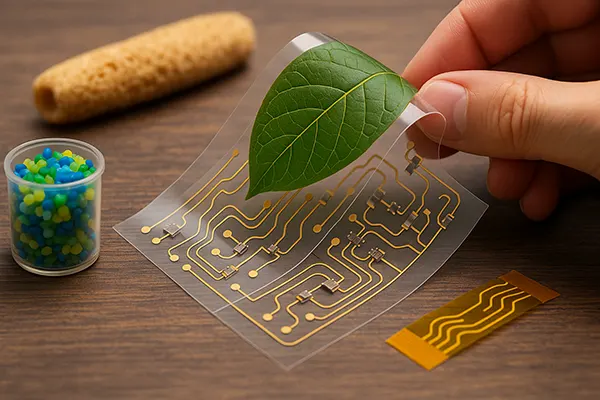In 2025, sustainable electronics have become one of the most promising areas of technological innovation. Researchers around the world are developing materials and devices that can heal themselves, decompose naturally after use, or bend and stretch without losing performance. These advancements mark a shift towards a more responsible and environmentally conscious approach to electronic design, aiming to reduce electronic waste and extend product life.
Types of Sustainable Electronic Materials
Modern sustainable electronics rely on advanced materials with properties far beyond those of traditional rigid silicon-based components. Among them are polymers capable of self-healing when damaged, biodegradable circuits that dissolve under specific conditions, and highly flexible substrates ideal for wearable or implantable technologies. Each category contributes to making future electronics more adaptive and eco-friendly.
Self-healing polymers are among the most fascinating developments. These materials use reversible chemical bonds that reform after being broken, restoring their mechanical and electrical integrity. For example, polyurethane-based materials embedded with microcapsules can repair microcracks autonomously, maintaining conductivity and preventing device failure.
Equally important are biodegradable materials made from natural compounds such as cellulose, silk fibroin, or polylactic acid. These enable devices to safely degrade after their functional life, eliminating the need for recycling and reducing pollution caused by electronic waste. Such designs are particularly useful for temporary medical sensors and environmental monitoring devices.
Flexible and Stretchable Substrates
Flexibility is another core feature of sustainable electronics, opening new horizons in sensor design and wearable devices. Flexible substrates, often made from elastomeric polymers, allow sensors and circuits to conform to irregular surfaces such as human skin or organic tissues. This property enhances comfort and accuracy in medical and sports monitoring applications.
Stretchable electronics combine mechanical resilience with electrical performance. They are often based on hybrid materials integrating conductive nanowires or carbon nanotubes within an elastic matrix. This design ensures stability even under deformation, a critical requirement for real-time physiological data collection in wearable systems.
In 2025, leading research centres in Japan, South Korea, and Germany are pushing the limits of flexible materials, demonstrating sensors that can withstand repeated bending cycles without degradation. These technologies are now being explored for soft robotics, electronic textiles, and implantable medical systems.
Technical Challenges and Reliability
While sustainable materials offer exciting possibilities, they also present significant engineering challenges. Ensuring long-term stability, maintaining consistent conductivity, and protecting devices against environmental stressors such as moisture and temperature variations remain complex tasks. For biodegradable materials, finding the right balance between durability during use and controlled degradation after disposal is crucial.
Reliability testing has become a priority. Researchers are developing accelerated ageing tests that simulate years of wear within weeks. These methods help predict how materials behave under mechanical strain or exposure to humidity. Such testing is essential for validating the safety and performance of medical or environmental sensors that rely on organic components.
Another challenge lies in large-scale manufacturing. Many self-healing or biodegradable materials are still in laboratory development stages, with limited production capacity. Scaling up while keeping costs and environmental footprints low is one of the key objectives for sustainable electronics over the next decade.
Lifecycle and Environmental Impact
The environmental benefits of sustainable electronics are significant. By extending the operational lifespan of devices and minimising e-waste, these materials contribute to a circular economy model. Self-healing properties reduce maintenance costs and the frequency of replacements, while biodegradable designs prevent long-term pollution in landfills.
Life-cycle analysis (LCA) is now widely used to assess the full environmental footprint of these technologies. Researchers consider not only the production and use phases but also the end-of-life scenarios to ensure a genuine reduction in ecological impact. According to 2025 reports from the European Environment Agency, incorporating biodegradable electronics could cut e-waste by up to 40% within the next 15 years.
Furthermore, sustainable design principles encourage the integration of renewable resources, such as biopolymers derived from agricultural waste. This approach not only reduces dependency on fossil-based plastics but also promotes local material sourcing, fostering regional sustainability.

Applications in Medicine and the Environment
Practical applications of sustainable electronics are already reshaping several industries. In healthcare, self-healing and flexible sensors are used for continuous monitoring of vital signs without causing discomfort. Biodegradable implants capable of transmitting data for a specific period before safely dissolving are being tested in clinical trials, reducing the need for surgical removal.
In environmental science, biodegradable sensors are deployed in rivers, forests, and agricultural soils to monitor pollution, humidity, and nutrient levels. Once their mission is complete, these devices decompose naturally, leaving no trace. This innovation offers a sustainable solution for large-scale environmental data collection.
Wearable technology also benefits greatly from these advancements. From fitness tracking textiles to smart patches for healthcare diagnostics, flexible and stretchable materials provide improved comfort and reliability. They adapt seamlessly to movement and body temperature changes, ensuring consistent performance in real-world conditions.
Future Outlook and Research Directions
Looking ahead, sustainable electronics are expected to become a cornerstone of green innovation. The next generation of materials will combine multiple features – self-healing, biodegradability, and flexibility – into hybrid systems capable of adapting to different environments and user needs. Such multifunctional designs could revolutionise wearable health monitoring and environmental sensing.
Collaborations between academic institutions, technology companies, and policymakers are essential to accelerate the adoption of sustainable materials. In 2025, international research programmes funded by the European Commission and the US National Science Foundation are focusing on scalable fabrication techniques and improved recyclability of electronic components.
Ultimately, sustainable electronics aim to bridge the gap between performance and environmental responsibility. As research continues to mature, we can expect to see self-healing circuits, fully biodegradable devices, and flexible sensors integrated into everyday products, creating a more resilient and eco-conscious technological future.

